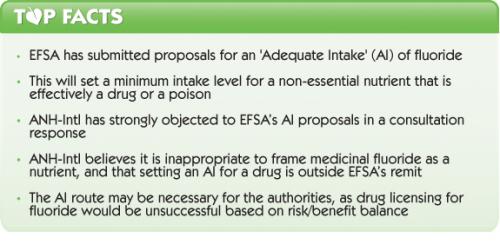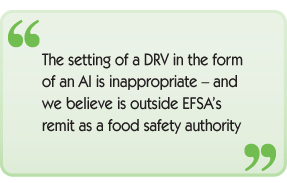Even though it admits that fluoride is not an essential nutrient, the European Food Safety Authority (EFSA) has released proposals for an ‘Adequate Intake’ (AI) of artificial fluoride salts. ANH-Intl believes it is entirely inappropriate to set a dietary reference value (DRV) for what is effectively a drug or poison – and our consultation response to EFSA, submitted last Friday, makes this very clear.

Setting ‘Adequate Intake’ of fluoride
EFSA was asked by the European Commission (EC) to publish a Scientific Opinion on Dietary Reference Values for fluoride, and the draft was released for public consultation in March of this year. EFSA has presented the DRV as an AI of fluoride from all sources, including non-dietary sources. EFSA considers that an AI is appropriate because of, “The beneficial effects of dietary fluoride on prevention of dental caries”.
The draft Scientific Opinion concludes as follows: “The AI of fluoride from all sources (including non-dietary sources) is 0.05 mg/kg body weight per day for both children and adults, including pregnant and lactating women. For the latter, the AI is based on the body weight before pregnancy and lactation”.
Key points raised in ANH-Intl’s consultation response
- The definition of a medicine in European law (Directive 2001/83/EC, amended by Directive 2004/27/EC) is any substance that is used either to “treat or prevent disease” or one that is used, “With a view to restoring, correcting or modifying physiological functions by exerting a pharmacological, immunological or metabolic action” (Article 1(2), Directive 2004/27/EC). As such, the use of fluoride to prevent dental caries (a preventable infectious disease) is obviously a medicinal use of fluoride, and the setting of a DRV in the form of an AI is, we believe, inappropriate – and outside EFSA’s remit as a food safety authority
- The doses of fluoride salts used to reduce the incidence of dental caries far exceed those of naturally occurring fluoride in drinking water or food. In effect, two separate and distinct pharmacokinetic profiles exist: one, involving very low doses of natural fluoride that exert their effects during the early years of tooth development; and another, involving much higher doses of artificial fluorides, which kill the bacteria associated with dental caries. Setting an AI for fluoride assumes that the mechanisms for risk (toxicity) or benefit and the dose-responses for both types of exposure are equivalent. They most certainly are not!
- In many ways, the Biocidal Products Directive (98/8/EC) is a more appropriate regulatory ‘home’ for artificial fluoride salts, because of their direct effects (interference with carbohydrate metabolism and acute toxicity) on caries-causing Streptococci
- The Commission’s own experts have clearly stated that there are no dental health benefits of fluoridated water over topical fluoride application. Water fluoridation is unnecessary in order for EU citizens to achieve the AI. The status of this science is likely the main reason why the vast majority of EU Member States have rejected municipal water fluoridation schemes, Ireland and the UK being the conspicuous exceptions
- Reduction of dental caries is the primary stated benefit of fluoride intake, but the benefits may have been exaggerated. The intake–response curve for fluoride, as drawn in 1997 by the Institute of Medicine (IOM), suggests a significant dose response at doses ≥1 mg/L. However, a plot of the original data points performed by ANH-Intl executive & scientific director, Robert Verkerk PhD, in a peer-reviewed paper (Toxicology 2010;278:27–38), produced a more or less flat response and demonstrated a clear overlap of risk and benefit
- EFSA’s usual procedure for assessing nutrient risk is to use the most sensitive adverse effect as the basis for setting upper limits. Exclusively in the case of fluoride, EFSA’s attitude appears to be that dental fluorosis is of cosmetic significance unless severe. This view is irrational, since it is well known that even slight pitting of the enamel associated with moderate fluorosis creates increased accumulation of bacteria or food particles, which worsen dental caries. There is further evidence that dental fluorosis might be viewed as aesthetically unpleasing to adolescents, leading to adverse psychological impacts on children
- Most health authorities that have evaluated the risks of fluoridation have not distinguished between the different forms of fluoride that have been subject to the various studies. For example, calcium fluoride, the principal form of naturally occurring fluoride in mineral waters, is very poorly absorbed by the body, and most of what is ingested is excreted. Synthetic fluorides, in contrast, such as the industrial-grade sodium hexafluorosilicic acid that is generally added to municipal fluoridation schemes, are almost completely absorbed. Many of the older studies were undertaken using less bioavailable forms of fluoride, such as calcium fluoride or pharmaceutical grade sodium fluoride.

Conclusion
We argue that the setting of an adequate (minimum) intake level, similar to a recommended daily allowance (RDA) for vitamins, minerals and other essential nutrients, is completely inappropriate for fluoride. The authorities, which still appear wedded to the notion of using fluoride to protect children from dental caries, may consider they have no option but to treat fluoride as a food ingredient. They likely recognise that synthetic, industrial-grade hydrofluorosilicic acid – the form of fluoride generally added to drinking water – would be deemed unacceptable under a drugs regime, based on a balance of risk and benefits. Therefore, by maintaining fluoride within a food regime, fluoridation schemes can be justified – despite needing to dramatically bend the rules to avoid fluoride’s classification as a drug or biocide!
In addition, the evaluation of artificial fluorides is outside EFSA’s remit, and the publication of an AI provides a spurious justification for the levels required (0.7–1.5 mg/L) to yield a medicinal effect in water fluoridation schemes. This is despite clear evidence of harm of these concentrations, especially to children.
We will keep you informed of developments when EFSA publishes its response to ANH-Intl and the other consultation stakeholders.
ANH Europe Clean Drinking Water campaign page








Comments
your voice counts
25 June 2013 at 4:39 pm
The EFSA are doing their best to limit the effectiveness of herbal remedies, they set ridiculously low RDAs for vitamins and and now they claim fluoride salts are essential to human health. I note they say fluoride salts and not specifically calcium fluoride so that they can conveniently approve fluorosilicic acid. Whose health are they looking after, ours or the financial health of the chemical-pharmaceutical-medical combine?
Your voice counts
We welcome your comments and are very interested in your point of view, but we ask that you keep them relevant to the article, that they be civil and without commercial links. All comments are moderated prior to being published. We reserve the right to edit or not publish comments that we consider abusive or offensive.
There is extra content here from a third party provider. You will be unable to see this content unless you agree to allow Content Cookies. Cookie Preferences